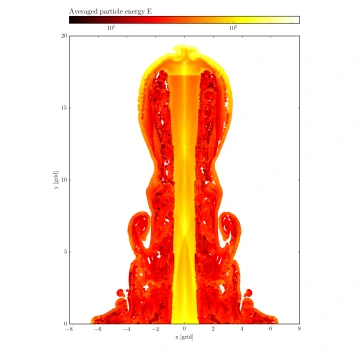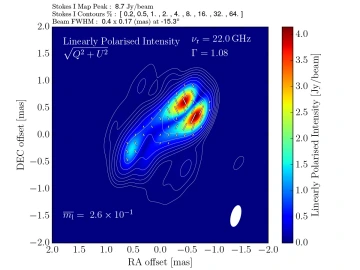Joana Kramer, Los Alamos National Laboratory

When
Refreshments served at 3:00 in the 3rd floor Atrium
TAP Computation & Data Initiative Lecture
Joana Kramer, Los Alamos National Laboratory
Visit Dates: Sep 28 - Oct 2
Title: Simulating Active Galactic Nuclei: From Relativistic Jets to Polarized Emission

Abstract: Active Galactic Nuclei (AGN) are among the most energetic phenomena in the Universe, powered by accretion onto supermassive black holes and often launching collimated relativistic jets that extend over kiloparsec scales. These jets, observable across the electromagnetic spectrum, emit synchrotron radiation that is inherently polarized, offering a unique window into the plasma composition and magnetic field geometry near the black hole. To model these complex systems, we employ Relativistic Magnetohydrodynamics (RMHD), solving the coupled equations of motion for magnetized, relativistic fluids using codes such as PLUTO. These simulations provide insight into jet launching, propagation, and internal shock structures by resolving key physical variables like pressure, density, velocity, and magnetic field strength.
Building on RMHD results, we apply radiative transfer techniques to compute synchrotron emission and polarization properties, using tools such as RADMC-3D or custom ray-tracing codes. These post-processing methods incorporate non-thermal electron distributions and account for cooling processes, allowing for full-Stokes (I, Q, U, V) imaging of jets under various magnetic field configurations.

To connect theory with reality, we generate synthetic observations that can be directly compared to multi-frequency VLBI data, including from the VLBA, GMVA, and EHT. These comparisons are crucial for constraining jet composition (e.g., electron-proton vs. pair plasma), magnetic field morphology (e.g., toroidal vs. poloidal), and the role of relativistic effects such as Doppler beaming.
This talk introduces the layered methodology of AGN jet simulation: from fundamental fluid dynamics to the polarized radiation emerging from these exotic objects — and how these synthetic predictions are matched against observations across the radio to X-ray regime.
Bio: Dr. Joana Anna Kramer is a postdoctoral researcher at Los Alamos National Laboratory in New Mexico, within the T‑2 group for Nuclear & Particle Physics, Astrophysics & Cosmology. She leads simulations of cosmic plasma phenomena, particularly relativistic jets from active galactic nuclei (AGN) and X-ray binaries (XRBs), using advanced numerical tools. Previously, Joana earned her PhD at the Max Planck Institute for Radio Astronomy in Bonn, as part of the International Max Planck Research School for Astronomy and Astrophysics (IMPRS). Her doctoral thesis explored 3D relativistic magnetohydrodynamic (RMHD) simulations of AGN jets and full‑Stokes synthetic imaging using PLUTO and RADMC‑3D, focusing on how jet magnetic field morphology and non thermal electron physics influence polarized synchrotron emission. Joana’s research includes detailed comparisons between synthetic maps and observational data from programs like VLBA, MOJAVE, POLAMI, and participation in the Event Horizon Telescope Collaboration (EHT) and M2FINDERS initiative. As PI, she secured VLBA observing time to probe circular polarization and magnetic field structure in AGN cores. Joana studied Physics and later Astrophysics at the Rheinische Friedrich‑Wilhelms‑University Bonn, where she completed her bachelor’s thesis on TANAMI AGN imaging with the VLBA and her master’s thesis on RMHD jet simulations and ray‑tracing under Prof. Ros and Prof. Dr. MacDonald.

